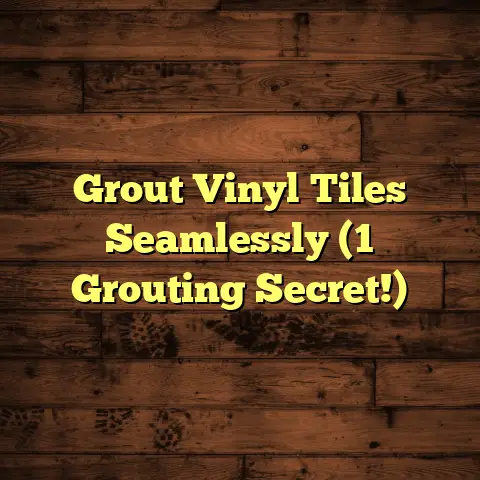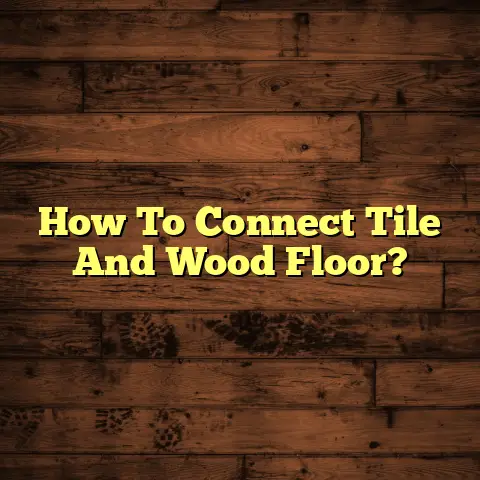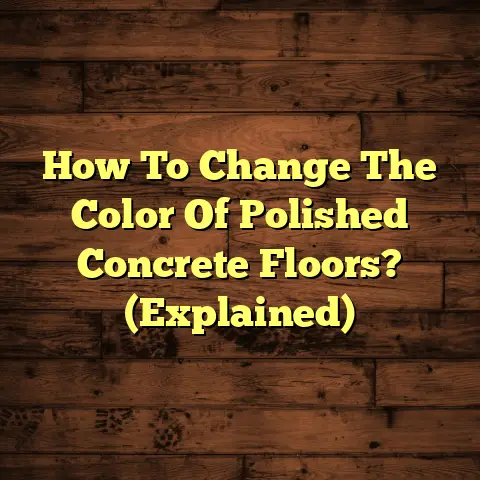Remove Hairspray On Tile Floors (4 Tricks!)
We live in an age where smart homes promise seamless living.
But let’s be real, even with all the gadgets, those pesky
cleaning challenges still pop up.
I’m talking about that
hairspray mist that settles on your tile, turning it into a
sticky, dull mess.
Don’t get me wrong, I love my smart thermostat and automated lights, but they can’t wipe up that hairspray!
In this article, I’m going to share four tricks I’ve learned
over the years to tackle this problem head-on.
These aren’t just quick fixes; they’re tried-and-true methods
that will restore your tile floors and keep your smart home
looking its best.
Let’s dive in and get those floors sparkling!
Section 1: Understanding the Problem
The Science of Hairspray
Ever wondered what makes hairspray so… well, sticky?
It’s a cocktail of ingredients, primarily polymers,
alcohol, and fragrances.
The polymers are the real culprits
here.
They’re designed to hold your hair in place, creating a
film that, unfortunately, also loves to cling to tile.
Think of it like this: hairspray is designed to create a
flexible, yet firm hold.
When it lands on your tile, the
alcohol evaporates, leaving behind those polymers.
These polymers can then attract dust and dirt, creating a
build-up that makes your tile look dull and feel sticky.
I’ve seen cases where the build-up is so thick, it actually changes the color of the grout!
The Impact on Smart Homes
Now, how does this relate to your smart home?
Well, we often assume that smart tech eliminates all the
nitty-gritty work.
But the truth is, a smart home still needs
regular, hands-on cleaning.
Ignoring the maintenance of
physical spaces can undermine the entire vibe of your smart
setup.
Imagine having a state-of-the-art entertainment system
in a room with grimy, hairspray-covered floors.
Not exactly the picture of a modern paradise, right?
According to a recent survey by the National Association of Home Builders, homeowners spend an average of $800 annually on home maintenance.
While smart tech can help manage some aspects, like scheduling cleaning reminders, it can’t replace good old-fashioned elbow grease.
It’s a common misconception that smart technology can
eliminate all cleaning needs.
I’ve had clients tell me they
thought their robot vacuum would handle everything.
While those little guys are great for daily upkeep, they can’t tackle set-in hairspray residue.
Section 2: The Importance of Tile Floor Maintenance
Why Tile Floors Matter
Let’s talk about why we even bother with tile in the first place.
For me, tile floors are a no-brainer.
They’re incredibly
durable, easy to maintain, and come in a million different
styles.
You can find tile that mimics wood, stone, or even
concrete.
Plus, they’re fantastic for high-traffic areas and homes with pets.
One of the biggest advantages of tile is its water resistance.
Unlike hardwood, you don’t have to worry about spills causing
permanent damage.
This is especially important in bathrooms and kitchens, where moisture is a constant concern.
When you link these benefits to the smart home concept, you see how well-maintained floors contribute to a cohesive and attractive living environment.
Imagine walking into your smart home and being greeted by
pristine, gleaming tile floors.
It sets the tone for the
entire space.
The Consequences of Neglect
So, what happens when you let those hairspray stains linger?
Well, first off, it’s just unsightly.
Nobody wants to see
sticky, dull patches on their floors.
But the problems go beyond aesthetics.
Untreated hairspray can
attract more dirt and grime, creating a breeding ground for
bacteria.
This can impact your indoor air quality, especially if you have allergies or respiratory issues.
I’ve also seen cases where the hairspray residue actually damages the tile’s finish over time, leading to permanent discoloration.
And let’s not forget about the grout!
Grout is porous, meaning
it easily absorbs stains and odors.
Hairspray can seep into the
grout, making it even harder to clean.
According to the EPA, poor indoor air quality can lead to a range of health problems, including headaches, fatigue, and even respiratory illnesses.
Keeping your tile floors clean is not just about looks; it’s about maintaining a healthy living environment.
Section 3: Trick #1 – The Power of Vinegar
How Vinegar Works
Alright, let’s get to the good stuff!
My first trick is using
good old vinegar.
I’ve been using vinegar for years, and it’s a staple in my
cleaning arsenal.
The science behind it is pretty simple:
vinegar is acidic, and that acidity helps break down sticky
residues like hairspray.
It’s also a natural disinfectant, so you’re not just cleaning; you’re sanitizing too!
The acetic acid in vinegar is what does the trick.
It reacts
with the polymers in hairspray, loosening their grip on the
tile surface.
Plus, vinegar is non-toxic and readily available, making it a safe and eco-friendly cleaning option.
Step-by-Step Instructions
Here’s how to use vinegar to banish that hairspray:
Mix Your Solution: In a bucket, combine equal parts white vinegar and warm water.
I usually start with 1 cup of each.Apply Liberally: Dip a mop or sponge into the solution and apply it generously to the affected areas.
Make sure to saturate the hairspray residue.Let It Sit: Give the vinegar solution about 5-10 minutes to work its magic.
This allows the acetic acid to break down the hairspray.Scrub Gently: Use a soft-bristled brush or sponge to gently scrub the tile.
Pay extra attention to the grout lines.Rinse Thoroughly: Rinse the floor with clean water to remove any vinegar residue.
You don’t want your floors smelling like a salad dressing!Dry Completely: Use a clean towel or mop to dry the floor.
This will prevent water spots and streaks.
Expected Results
After using this method, you should see a noticeable
difference in your tile floors.
The hairspray residue will be
gone, leaving behind a clean, streak-free shine.
The vinegar will also help to remove any lingering odors, leaving your home smelling fresh and clean.
In my experience, vinegar works best on light to moderate
hairspray buildup.
For tougher stains, you might need to
repeat the process or try one of the other tricks I’m going to
share.
One thing to keep in mind is that vinegar can have a strong
odor.
If you’re sensitive to smells, you can add a few drops
of essential oil to the solution.
Lemon, lavender, or eucalyptus are all great options.
Section 4: Trick #2 – Baking Soda Paste
Why Baking Soda?
Next up, we have baking soda.
This is another one of my go-to
cleaning solutions, especially for tough stains.
Baking soda is a mild abrasive, meaning it can gently scrub
away dirt and grime without scratching your tile.
It’s also a
natural deodorizer, so it can help to eliminate any lingering
odors from the hairspray.
The key to baking soda’s cleaning power is its ability to react with acids and bases, neutralizing them and loosening their grip on surfaces.
Preparation and Application
Here’s how to create and use a baking soda paste:
Make the Paste: In a small bowl, mix baking soda with enough water to form a thick paste.
I usually start with about 1/4 cup of baking soda and add water a little at a time until I get the right consistency.Apply to Stains: Apply the paste directly to the hairspray stains.
Make sure to cover the entire area.Let It Sit: Allow the paste to sit for about 15-20 minutes.
This gives the baking soda time to penetrate the stain and loosen it.Scrub Gently: Use a soft-bristled brush or sponge to gently scrub the area.
You might need to apply a little elbow grease for tougher stains.-
Rinse Thoroughly: Rinse the area with clean water to remove all traces of the baking soda paste.
-
Dry Completely: Use a clean towel or mop to dry the area.
Follow-Up Care
After using baking soda, it’s important to rinse the area
thoroughly to avoid any residue.
Baking soda residue can leave
a white, powdery film on your tile, so you want to make sure
you get it all off.
You can also use a damp cloth to wipe down the area after
rinsing.
This will help to remove any lingering residue and
leave your tile looking sparkling clean.
In my experience, baking soda works best on dried-on hairspray
stains.
It’s also great for removing stains from grout.
One thing to keep in mind is that baking soda can be a bit
messy.
Make sure to protect your surrounding surfaces before
you start cleaning.
You can use a drop cloth or some old towels to catch any spills or splatters.
Section 5: Trick #3 – Rubbing Alcohol Solution
Understanding Rubbing Alcohol
My third trick involves rubbing alcohol.
This is a powerful
solvent that can dissolve hairspray and other sticky
substances.
Rubbing alcohol, also known as isopropyl alcohol, is a
fantastic degreaser and disinfectant.
It works by breaking
down the chemical bonds in hairspray, making it easier to
remove.
Plus, it evaporates quickly, so you don’t have to worry about leaving behind any moisture.
How to Use It
Here’s how to prepare a rubbing alcohol cleaning solution:
Mix Your Solution: In a spray bottle, combine equal parts rubbing alcohol and water.
I usually start with about 1/2 cup of each.Spray the Area: Spray the solution directly onto the hairspray stains.
Make sure to saturate the area.Let It Sit: Allow the solution to sit for about 2-3 minutes.
This gives the rubbing alcohol time to dissolve the hairspray.Wipe Clean: Use a clean cloth or sponge to wipe the area clean.
You should see the hairspray residue coming off easily.-
Dry Completely: Use a clean towel or mop to dry the area.
Safety Tips
When using rubbing alcohol, it’s important to take a few safety precautions.
First, make sure to work in a well-ventilated area.
Rubbing
alcohol can release fumes that can be irritating to your lungs.
Second, avoid using rubbing alcohol near open flames or heat
sources.
Rubbing alcohol is flammable, so you want to be
careful.
Third, keep rubbing alcohol out of reach of children and pets.
It can be toxic if ingested.
In my experience, rubbing alcohol works best on fresh hairspray
stains.
It’s also great for removing sticky residue from other
surfaces, like mirrors and windows.
One thing to keep in mind is that rubbing alcohol can be drying
to your skin.
If you’re going to be using it for an extended
period of time, you might want to wear gloves.
Section 6: Trick #4 – Commercial Cleaners
When to Use Commercial Cleaners
Sometimes, despite our best efforts, those hairspray stains just
won’t budge.
That’s when it might be time to bring in the big
guns: commercial cleaners.
I usually recommend trying the natural methods first, but if you’re dealing with persistent or large-scale hairspray buildups, a commercial cleaner might be necessary.
These cleaners are specially formulated to break down tough stains and grime, and they often contain stronger solvents than you’ll find in household products.
Choosing the Right Product
When selecting a commercial cleaner, it’s important to choose one that is safe for tile floors and effective against hairspray.
Look for products that are specifically designed for use on
tile and grout.
Avoid cleaners that contain harsh chemicals,
like bleach or ammonia, as these can damage the tile’s finish.
You should also read the product label carefully to make sure
it’s safe for your particular type of tile.
Some tiles are
more sensitive to certain chemicals than others.
I’ve had good results with commercial cleaners that contain
enzymes.
These enzymes break down organic matter, making it
easier to remove stains and odors.
Application Techniques
Here’s how to use commercial cleaners effectively:
Read the Instructions: Always read the product label carefully before using a commercial cleaner.
Follow the manufacturer’s instructions for application and safety precautions.-
Test in an Inconspicuous Area: Before applying the cleaner to the entire floor, test it in an inconspicuous area to make sure it doesn’t damage the tile.
Apply the Cleaner: Apply the cleaner to the affected areas.
You can use a mop, sponge, or spray bottle, depending on the product.Let It Sit: Allow the cleaner to sit for the recommended amount of time.
This gives it time to penetrate the stain and loosen it.-
Scrub Gently: Use a soft-bristled brush or sponge to gently scrub the area.
-
Rinse Thoroughly: Rinse the floor with clean water to remove all traces of the cleaner.
-
Dry Completely: Use a clean towel or mop to dry the floor.
When using commercial cleaners, it’s important to wear gloves
and eye protection.
You should also work in a well-ventilated
area to avoid inhaling any fumes.
Section 7: Preventative Measures
Proactive Cleaning Habits
The best way to deal with hairspray stains is to prevent them from happening in the first place.
Incorporating cleaning into your regular routine can go a long way in preventing hairspray buildup.
I recommend wiping down your tile floors at least once a week
with a damp mop or cloth.
This will help to remove any dirt,
dust, and hairspray residue before it has a chance to build up.
You can also use a doormat to trap dirt and debris before it gets tracked onto your tile floors.
And if you spill something, clean it up immediately.
The longer
a spill sits, the harder it will be to remove.
Smart Home Solutions
Believe it or not, your smart home devices can actually help you maintain cleanliness.
Robotic vacuums are great for daily upkeep.
You can schedule
them to run automatically, keeping your floors free of dirt and
debris.
There are also smart mops designed for tile floors.
These mops
can be programmed to clean your floors on a regular basis,
removing dirt and grime with ease.
Some smart home systems even have sensors that can detect spills and automatically send a cleaning alert to your phone.
These technologies can help you stay on top of your cleaning routine, making it easier to prevent hairspray buildup and other stains.
Conclusion: The Path to Pristine Tile Floors
So, there you have it!
Four tricks that will help you remove
hairspray from your tile floors and keep your smart home looking
its best.
Remember, while technology can assist with many aspects of home management, traditional cleaning methods remain crucial for tackling specific challenges like hairspray stains.
I encourage you to try these tricks and see which ones work
best for you.
With a little elbow grease and the right
techniques, you can keep your tile floors looking beautiful for
years to come.
And don’t forget, a clean home is a happy home.
So, get out
there and start cleaning!
Your tile floors will thank you for
it.





